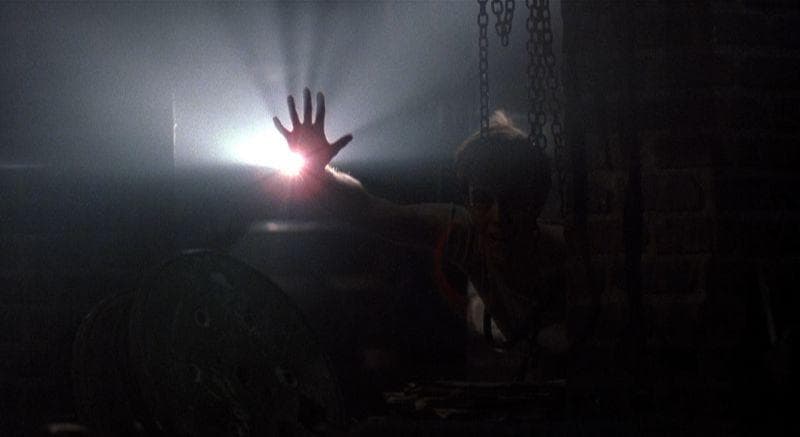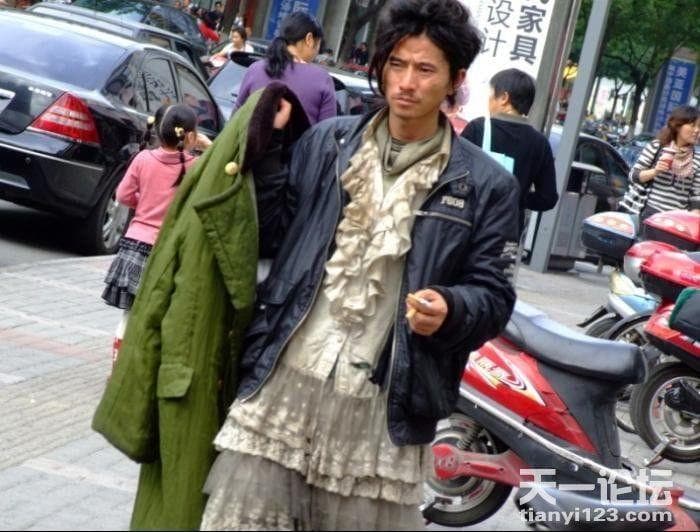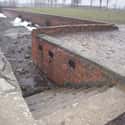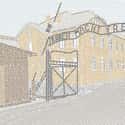-
(#1) The Four-Day Train Ride To Auschwitz, During Which 80 People Rode In Each Cattle Car
When the Nazis decided Auschwitz would serve as the focal point for the extermination of Jews and various other groups, they were faced with the logistics of transporting millions of people to southern Poland, some from as far away as the Netherlands, France, Italy, and Greece. Transportation was done by railroad, typically in cattle cars, but occasionally in passenger trains, in which wealthy Jews were encouraged to bring as much of their wealth with them as possible.
A typical journey is described in the book Perfidy, written by Ben Hecht and compiled from transcripts of the trial of Rudolf Kastner, a Hungarian Jew tried for collaboration with the Nazis in Hungary:
The Jews are deported to Auschwitz daily, on schedule. They leave from the ghetto embarkation depots, on schedule. Conductors signal, "All aboard." Brakemen wave lanterns. German and Hungarian guards shoot a few reluctant travelers, club and bayonet a last group of mothers into the compartments. The engineer opens his throttle. And the train is off for Auschwitz, on schedule.
Eighty Jews ride in every compartment. Eichmann [said] the Germans could do better where there were more children. Then they could jam 120 into each train room. But 80 is no reflection on German efficiency.
The 80 Jews must stand all the way to Auschwitz with their hands raised in the air, so as to make room for the maximum of passengers.
There are two buckets in each compartment. One contains water. The other is for use as a toilet, to be shoved by foot, if possible, from user to user.
I wonder here, why the water and toilet buckets? One water bucket, one toilet bucket for 80 despairing men, women and children plastered against each other as in a packing case, and riding to death. Why? One water bucket, one toilet bucket are not enough to relieve the misery of these barely living ones. Jammed together, how can they use any buckets? They must urinate and defecate in their clothes. They must continue to burn with thirst until they arrive at the gas ovens. But the buckets are there.
These transports typically took four days to reach Auschwitz. One infamous transport from the Greek island of Corfu took 18 days. Upon arrival, all of its inhabitants were dead.
-
(#2) The Initial Selection Process At Auschwitz: Either The Gas Chamber Or Slavery
Jacki Handali and Rita Weiss survived transport and imprisonment in Auschwitz. Their selection experiences were similar; each describes a quick, methodical process designed to create as much compliance as possible. Deportees were forcibly removed from freight cars, told to leave their luggage behind, and quickly separated by sex.
SS doctors had the groups form one line each and began separating the lines by motioning individuals to the left or right. Left meant death in the gas chamber, right meant assignment to a work detail in the camp. Until 1944, when massive transports were processed on a 24-hour basis, trains would typically be emptied in the middle of the night or early morning, the timing meant to disorient victims as much as possible.
Resistance or questioning of authority was met with assaults with whips, rifle butts, and dogs. Children and relatives were forcibly and quickly separated, frequently with families unaware of what had happened to their loved ones until much later. A woman who refused to give her baby to a camp guard was sent into the gas chamber with her child in her arms.
-
(#3) Nazis Maintained Calm In The Gas Chambers Through Deliberate Psychological Manipulation
The Nazis exterminated thousands of people when a new train convoy arrived at an extermination camp, and dozens of workers handled the most distasteful aspects of this process. Almost always Jews, these workers were known as Sonderkommando - literally "task force" or "special force." The Final Solution was an unspoken secret even within the Nazi hierarchy, and camp authorities took great pains to ensure that no physical evidence, such as photographs of their deeds, existed.
To eliminate witnesses, the Sonderkommando were exterminated every three months or so until late 1944, when Heinrich Himmler, aware Germany would lose the war, suspended transports to, and mass killings within, Auschwitz. Because of this, some Sonderkommando survived, and in the confusion of the last days of the camp, they were able to blend in with regular workers before the forced march west, away from the Soviet occupation of Auschwitz.
One of these individuals, Shlomo Venezia, survived not only the Sonderkommando, but also a forced march to Mauthausen concentration camp. In 1992, to combat what he felt to be a resurgence of anti-Semitism, Venezia began discussing his Auschwitz experience. In 2007, he published a book. His account was very specific regarding the process that awaited those who had been condemned to die:
Every time a new convoy arrived, people went in through the big door of the Crematorium and were directed towards the underground staircase that led to the undressing room. There were so many of them that we saw the queue stretching out like a long snake.
As the first of them were entering, the last were still a hundred yards or so behind. After the selection on the ramp, the women, children and old men were sent in first, then, the other men arrived.
In the undressing room, there were coat hooks with numbers all along the wall, as well as little wooden planks on which people could sit to get undressed. To deceive them more effectively the Germans told people to pay particular attention to the numbers, so that they’d be able to find their things more easily when they came out of the "shower."
After a time, they also added an instruction to use the laces to tie shoes in pairs. In fact, this was to facilitate the process of sorting out when the things arrived at the Kanadakommando. These instructions were generally given by the SS standing guard, but it sometimes happened that a man in the Sonderkommando could speak the language of the deportees and transmit these instructions to them directly.
To calm people down and ensure they’d go through more quickly, without making any fuss, the Germans also promised them they’d have a meal just after "disinfection." Many of the women hurried up so as to be first in line and get it all over with as quickly as possible - especially as the children were terrified and clung to their mothers. For them, even more than for the others, everything must have been strange, eerie, dark and cold.
-
(#4) Zyklon B Took 10 To 12 Minutes To Do Its Job, During Which Nazis Stood Around Waiting
The Sonderkommando were present at all times during the gassing process, frequently conversing with the victims in their native languages. Shlomo Venezia described what unfolded once the victims undressed and were bolted into the chamber behind a hermetically sealed door:
Once they had taken off their clothes, the women went into the gas chamber and waited, thinking that they were in a shower, with the shower heads hanging over them. They couldn’t know where they really were. A woman would sometimes be seized by doubt when no water came out and went to see one of the two Germans outside the door. She was immediately beaten and forced to go back in; that took away any desire she might have to ask questions.
Then the men, too, were finally pushed into the gas chamber, the Germans thought that if they made thirty or so strong men go in last, they would be able, with their force, to push the others right in. And indeed, herded by the rain of blows as if they were so many animals, their only option was to push hard to get into the room to avoid the beating.
That’s why I think that many of them were dead or dying even before the gas was released. The German whose job it was to control the whole process often enjoyed making these people, who were about to die, suffer a bit more. While waiting for the arrival of the SS man who was going to release the gas, he amused himself by switching the light on and off to frighten them a little bit more.
When he switched off the light, you could hear a different sound emerging from the gas chamber; the people seemed to be suffocating with anguish, they’d realized they were going to die. Then he’d switch the light back on and you heard a sort of sigh of relief, as if the people thought the operation had been canceled.
Then, finally, the German bringing the gas would arrive, it took two prisoners from the Sonderkommando to help him lift up the external trapdoor, above the gas chamber, then he introduced Zyklon B through the opening. The lid was made of very heavy cement. The German would never have bothered to lift it up himself, as it needed two of us.
Sometimes, it was me, sometimes others. I’ve never said this before, since it’s painful to admit that we had to lift the lid and put it back, once the gas had been introduced. But that’s how it was.
Once the gas had been thrown in, it lasted about ten to twelve minutes, then finally you couldn’t hear anything, not a living soul. A German came to check that everyone was really dead by looking through a peephole placed in the thick door - it had iron bars on the inside to prevent the victims from trying to smash the glass.
-
(#5) Jewish Slaves Had To Rip Gold Teeth From Gas Chamber Corpses Then Burn Them
The real tasks of the Sonderkommando began after a German officer determined the inhabitants of the gas chamber were all dead. Shlomo Venezia describes the gruesome aftermath of this process:
When he was sure that everyone was well and truly dead, he opened the door and came out right away, after starting the ventilation system. For twenty minutes you could hear a loud throbbing noise, like a machine breathing in air.
Then, finally, we could go in and start to bring the corpses out of the gas chambers.
A terrible acrid smell filled the room, we couldn’t distinguish between what came from the specific smell of the gas and what came from the smell of the people and the human excrement.
When the job of cutting the hair and pulling out the gold teeth had been completed, two people came to take the bodies and to load them onto the hoist that sent them up to the ground floor of the building, and the crematorium ovens.
All the rest, the undressing room and the gas chamber, was underground. Depending on whether the people were big, small, fat or thin, it was possible to load between seven and ten people onto the hoist.
On the floor above, two people collected the bodies and sent the lift back down, the hoist didn’t have any door, a wall blocked the one side, but when they reached floor level, the corpses were unloaded on the other side. The bodies were then dragged and laid out in front of the ovens, two by two.
In front of every muffle, three men were waiting to place the bodies in the oven. The bodies were laid out head to foot on a kind of stretcher. Two men, either side of the stretcher, lifted it with the help of a long piece of wood slipped underneath it. The third man, facing the ovens, held the handles that were used to push the stretcher into the furnace. They had to slip the bodies in and pull the stretcher out quickly, before the iron grew too hot.
The men in the Sonderkommando had got into the habit of pouring water onto the stretcher before disposing of the bodies, otherwise these remained stuck to the red-hot iron. In cases such as that, the work became very difficult, since the bodies had to be pulled out with a fork and pieces of skin remained attached.
When this happened, the whole process was slowed down and the Germans could accuse us of sabotage. So we had to move quickly and skillfully.
Any member of the Sonderkommando who stole valuables from corpses or who even mistakenly neglected to remove all of the gold from a body's teeth would be shot by an SS guard on the spot.
-

(#6) David Olere, A Member of the Sonderkommando, Related His Experience Through Art
David Olere was a French Jew arrested in 1943 and sent to Auschwitz. He was assigned to work in the Sonderkommando, but because he was an artist, he also was used by the SS as a translator and illustrator, decorating letters they sent home to loved ones. He is unique in the annals of Auschwitz in that he survived the Sonderkommando and provided drawings of what he witnessed while a prisoner.
He began these drawings in the later stages of the camp's existence and survived the forced march to Mauthausen, living in France until 1985, when he perished at the age of 83. His art serves as a tremendously powerful firsthand account of life in a Nazi extermination camp.
-
(#7) Anne Frank Ran Into Old Friends At A Concentration Camp, One Of Whom Lived To Tell Of It
Anne Frank and her family were arrested in Amsterdam on August 4, 1944, and deported to Auschwitz on September 3, 1944. Roughly half of their transport survived initial selection, including every member of the Frank family, although Anne's father, Otto, was separated from the other Franks, and they had no idea what happened to him. Anne and her sister, Margot, were transported to Bergen-Belsen in October 1944. Their mother remained in Auschwitz, where she perished of starvation. At Belsen, Anne encountered several school friends, all of whom were shocked by her skeletal appearance.
One, Nanette Blitz Konig, a classmate who was present at Anne's 13th birthday party, at which Anne received the gift of a blank diary from her parents, recalled:
I am the only one in that class who met her again in Bergen-Belsen. I was in camp seven and she was in camp eight. I met her several times and it was from Anne that I learnt what was happening in Auschwitz. She told me about her diary and that she wanted to use it for a book after the war, she never wanted to publish a diary. We talked about her going in to hiding, how hard life was in the hiding place. We were dreaming and we had to hope we would make it through. It was part of our survival. We were mature - the circumstances made us like that. We had all lost family and didn't know if we'd see them again. Everyone wanted to survive, nobody wanted to die willingly.
I saw Anne shortly before she died, Bergen-Belsen wasn't a death camp but the conditions eliminated people. It's very emotional. She didn't make it and I did. I still see her in front of me.
Like many interned at Belsen, both Anne and Margot contracted typhus in the late stages of the war. They both perished of the disease. Their exact dates of death have never been determined, but they are believed to have possibly lived as late as March 1945, only a month before the camp's liberation.
Nanette Blitz Konig's entire family, who were Jewish, were sent to Belsen in 1943. Only Nanette survived. After WWII, she met future husband John Konig and emigrated to Brazil, where she still lives today.
-

(#8) Alan Zimm Witnessed The Hanging Of 200 People At The Dora-Mittelbau Camp
In 1945, Polish Jew Alan Zimm was interned at the Dora-Mittelbau camp, where prisoners were forced to build munitions for the failing Nazi war effort. He describes the hanging of an entire factory's worth of prisoners after a machine needed to make rockets was sabotaged:
Beginning of March of '45, somebody sabotaged a part in the factory there. Not in our group. In another group. They destroyed a part of the... of a machine. Without the machine they couldn't finish the rocket. So they... without the part the rocket was unfinished. There was no way they could finish it.
What they did, they took 2,000 people from that compartment, from that group. And... put gallows in the middle of the factory, in the tunnel and hanged every one of them. They hanged them in pairs, the two. And everybody working in that factory, had to go into the tunnel, line up, and walk through underneath the gallows where the... those 200 people were hanging and come back to our work. They say, "See what's going to happen if you do the same thing what they did? You will hang."
-
(#9) Concentration Camp Tattoos Were Done With Crude Writing Instruments And Regular Ink
Maria Ossowski was a Polish member of the Resistance imprisoned in Auschwitz in 1943. She later recalled the first few minutes of captivity and the tattooing process in the camp:
Eventually we were herded into what was to be our washing room. It was a huge barrack, with the water running, cold water I must add, from the top, there were men in already prison garb, which we never seen before. We were made to strip, we were made to go in front - each one of us - in front of that man, that man or the other one, they were all standing in the line, and we were shaven - we were shaven - our heads were shaven, our private parts were shaven and we were pushed then under that water. And after a while we were pushed out of it into another part of that big block, where the huge amount of terrible-looking - and already smelling terrible - clothes were prepared for us.
What we actually got was one dress which you had to put over your head. The dress had sleeves, but not long, like three-quarter sleeves, and when we have had this on, we were marched again to another part, where the girls this time - prisoners obviously - were sitting by the little tables, and that, and then where we were getting our numbers tattooed on our arms. It was done with simply - [ballpoint pens] were not invented then - so it was just implement with which you write letters in those days, and it was put into the ink and the point was made on your arm 'til it had the shape of the number.
-
(#10) Prisoners Were Forced To Climb The Stairs Of Death
Mauthausen was the main political concentration camp in Austria. Although not an extermination camp, it's estimated that 100,000 people perished at Mauthausen between its inception in 1939 and May 5, 1945, when it became the last camp liberated by the Allies. The most notorious aspect of the camp was its proximity to a rock quarry, and its infamous Stairs of Death, which were described by many, including this account from a prisoner of Mauthausen in 1939:
Inmates were given light clothing and wooden (clogs) and put to work in the stone quarry. This involved carrying heavy stones up 180 steps, known as the "staircase of death" because of the beatings, shootings and fatal accidents to which the crowded mass of inmates was exposed to there. The food was totally inadequate for the heavy labor performed, and a stay in Mauthausen was indeed synonymous with "extermination by work."
Sometimes the object of climbing the Stairs of Death was not meaningful work but deliberate punishment and death. A famous incident involved 47 Allied aviators transported to the camp, who were essentially slain in September 1944. Maurice Lampe, a French political prisoner, testified at Nuremberg:
For all the prisoners at Mauthausen, the murder of these men has remained in their minds like a scene from Dante's Inferno. This is how it was done: at the bottom of the steps they loaded stones on the backs of these poor men and they had to carry them to the top. The first journey was made with stones weighing 25 to 30 kilos and was accompanied by blows. Then they were made to run down. For the second journey, the stones were even heavier; and whenever the poor wretches sank under their burden, they were kicked and hit with a bludgeon. Even stones were hurled at them... In the evening when I returned from the gang with which I was then working, the road which led to the camp was a bath of blood... I almost stepped on the lower jaw of a man. Twenty-one bodies were strewn along the road. Twenty-one had died on the first day. The twenty-six others died the following morning...
-
(#11) Isadore Helfing Escaped The Treblinka Death Camp, Which Only 27 People Survived
Treblinka was an extermination camp located in Poland that operated from July 1942 to October 1943. Although part of the camp was forced labor, its primary purpose was the extermination of Polish Jews from Warsaw and other Polish ghettos. As many as 900,000 Jews perished at Treblinka; only Auschwitz was deadlier. Because the camp was smaller than Auschwitz, it didn't require as many laborers to operate. Therefore, only a tiny number of individuals sent to Treblinka survived.
One of these, Isadore Helfing, managed to secure a position in the camp stable, away from the extermination camp and the Sonderkommando, who were routinely killed. Nevertheless, Helfing and others knew by August 1943 that the Germans would eventually close Treblinka and exterminate any prisoners left. In response, an uprising took place that Helfing described:
Not everybody in the camp knew there’s going to be an uprising. And I was told when you hear the uprising, when I hear the uprising, I should grab the rifle from the Ukrainian because he had a rifle laying there openly... I got the access to it all the time, but he didn’t care because I been there a few months there.
So they told me that if you hear the uprising, grab that rifle and run with us in the uprising...
Somehow, it was delayed and the people who knew about it didn’t know what to do. So the uprising was a little later, and maybe two or three of the Germans were killed and then we start running. The wires, you know, the wires around the barracks, was not electric. In Treblinka they didn’t make any tattoos on your arms. You wear the clothes which you wear all the time.
That was, that’s the way this camp was... So, so we run, we start running and I jumped across the wires and the people you know... the patrols start shooting left and right.
I was running in the field and I saw bullets popping in the ground in front of me... then it got dark and I got into deep woods because we, from the distance we see black, this was woods. We were running straight into the woods, and we hid out overnight.
So the next day we didn’t know where to go, I saw a little farm, a farmer all by himself. I was with another guy, and we got into his place and we told him the story and he kept us hidden, but later he used us as to help him work.
A handful got away. The rest, all of them were killed right on the spot.
After the war, we tried to get together how many people survived. Was only 27 people from Treblinka... All together was 27. 27 people after the liberation.
The Germans closed Treblinka in October 1943 and attempted to destroy or conceal any evidence of its existence.
-
(#12) Chemist Primo Levi Was Spared Death By His Skills But Witnessed Countless Horrors
Surviving the initial selection process at Auschwitz merely qualified a prisoner to be assigned to extremely harsh conditions involving back-breaking labor and intentionally miniscule amounts of nourishment.
Primo Levi was a Jewish Italian chemist and eventual memoirist who was assigned to the Auschwitz-Monowitz labor camp, a satellite camp of Auschwitz that manufactured synthetic rubber. He arrived in February 1944 with 650 other Italian Jews, only 20 of whom survived. Because he was a chemist, he was of use in the camp laboratory, where he also managed to surreptitiously acquire additional food. Thus he avoided the hard labor and freezing climate that deliberately doomed most of the other inmates within 90 days.
During periodic selections, prisoners were forced to strip naked. Those deemed too exhausted or sick to provide meaningful labor were designated for transport to Auschwitz-Birkenau and the gas chamber. Unlike newer prisoners, they knew exactly what awaited them. Levi's description of this process from his work The Drowned and the Saved explains how most were already too mentally defeated and humiliated to resist:
The day in the [camp] was studded with innumerable harsh strippings - checking for lice, searching one’s clothes, examining for scabies and then the morning wash-up - as well as for the periodic selections, during which a "commission" decided who was still fit for work and who, on the contrary, was marked for elimination. Now a naked and barefoot man feels that all his nerves and tendons are severed: He is helpless prey. Clothes, even the foul clothes distributed, even the crude clogs with their wooden soles, are a tenuous but indispensable defense. Anyone who does not have them no longer perceives himself as a human being but rather as a worm: naked, slow, ignoble, prone on the ground. He knows that he can be crushed at any moment.
Primo Levi perished in 1987 after a fall from a three-story building. Whether his death was a suicide or an accident is still a matter of debate within the literary community.
-

(#13) Nazis Offered Internees Easy Jobs To Grant False Hope Before Murdering Them While Laughing
Premsyl Dobias was a member of the Czech Resistance who was arrested and sent to Mauthausen. He survived, emigrated to Great Britain, and subsequently related his experiences there to the British Imperial War Museum's digital archive.
One story is particularly disturbing:
The SS told us in German that they needed some prisoners who knew... who were from the farm, who knew how to feed pigs, and they would then come every day from the camp direct to that farm to look after the pigs. Obviously, everybody wanted to get away from the hard work in the camp and there were - all of them were volunteers.
The SS told us he had to have only those who were from a farm and who knew... who spoke German. That eliminated a few Spaniards who were in the group, but we were mostly Czechs, and even some Czechs didn’t know German. So finally the SS guard selected about, oh, 20 prisoners, lined them up, and I overheard the other one telling him: "Du hast zu viele" - you have too many.
So he started to push back a few, he pushed back two Spaniards, then he came to me, he pushed me back, and I was hoping so much to be able to be working on a farm, I was so hungry I hoped that I could actually eat with the pigs. So I came forward and in German, at attention, I told him that I was born on a farm and all I did all my life was feeding pigs - of course it was not true. But he very cruelly kicked me, I still have the mark on my leg, and pushed me back.
When he had finally selected about a dozen, I believe dozen to fifteen, he told them: "turn right, without step walk to that farm." And both of them remained behind the group which was marching very happily to the farm. That part of the camp was separated by guards and the guards had machine-guns to guard the outlines of the camp. We were very upset that we were left behind, and looked with envy at those who were marching to that farm.
But suddenly we heard machine-gun shooting from two sides and with horror we noticed that all the prisoners who were marching to that farm crossed the so-called border and were gunned down dead. I could have been one of them. Then the SS turned back, laughingly came back to our Kommando, we again stood at attention and one of them laughingly said "who else knows how to feed pigs?"
That is an experience which will haunt me all my life.
It’s a tremendous nightmare, to such an extent, that I could have never believed that a nation, civilized nation, which gave the world musicians, poets, experts in every field of science, how they could have been fooled by a maniac like Hitler is something which I will never understand.
-
(#14) German Jew Lucille Eichengreen, Who Survived Auschwitz And Bergen-Belsen, Tells Of Walking To The Bathroom Past Piles Of Corpses
Lucille Eichengreen was 16 when her family was forced into the Lodz Ghetto in Poland, and 19 when she arrived at Auschwitz in 1944. She spent two months at the Neuengamme slave labor camp at the end of 1944 before being transferred to Bergen-Belsen in 1945.
Eichengreen has written and spoken extensively about her experience. She revealed the following information during interviews conducted in California, where she settled after WWII, in 2002 and 2003.
On Auschwitz:
Q: In your book you mentioned that when your hair was shaven off it was very traumatic.
A: Yes it was. I saw a reflection in a glass pane. And it was an oval head with two big ears, and it looked horrible. I had long brown hair - longer than yours - and I would have preferred a number, but I didn't have a choice.
A: After arriving in Auschwitz were you directly shipped to Hamburg to work?
Q: No, we were a few weeks in Auschwitz until Dr. Mengele came and with other officers, two I think, and separated the younger ones from the older ones again. The younger ones were shipped to slave labor.
A: And during the few weeks that you were in Auschwitz, what were you doing?
Q: Nothing, Absolutely nothing. Standing at attention and being counted and recounted for most of the day. And otherwise just absolutely nothing. There was nothing to be done. And you couldn't walk around because the individual barracks were separated by barbed wires - electrical wires - and guard towers.
A: Can you describe a typical, 24-hour day in Auschwitz?
Q: You got up at 6 or 5 and had to go outside and line up in rows of 5, and be counted and recounted, and stand there for three, four hours. And eventually we got a liquid they called coffee, and maybe a piece of bread, but not everyday. And then we would go back into the barracks for a couple of hours, and then outside again to be counted and recounted. People fainted. People died. People were carried away. Some ended up in hospitals, some not. And that was all there was to a day. There was nothing else.
A: What memories are the strongest that you hold today from Auschwitz, particular memories of things that happened?
Q: The gas chambers, which I did not personally see or experience. The smoking chimneys, and the people with their shaven heads, and their rags which they wore. And the music in the background played by the camp orchestra. Those are the memories of Auschwitz.
A: Can you tell me more about the chimneys, and how you felt seeing them?
Q: Well at first, they didn't make sense because somebody said this is a crematorium. Whoever heard of a crematorium? And then the chimneys, and the smoke are of the burned bodies. If you hear it for the first time, you can't visualize it, and subsequently we heard of the gas chambers, and we couldn't visualize that either, but it was there, you had to accept it. But it was a concept which I had never read about, I had never heard about, I never knew it even existed.
A: When did it really start to process and make sense that it did exist?
Q: After a few weeks it processed. When we were transported to the slave labor camps, and when the German SS threatened, "We will send you to a camp that has a gas chamber," then it began to register.
On Bergen-Belsen:
Q: Can you describe your time in Bergen-Belsen?
A: There was nothing to be done in Bergen-Belsen. The barracks were overcrowded. If you wanted to walk to the latrine, it was a long walk and the walkways were covered with dead bodies. Food came in very seldom. The barracks opposite ours were women from Czechoslovakia. The barracks in back of us were the Dutch. And it was just a day-to-day existence. It smelled terribly from the decaying bodies. And we knew that nobody could last very long in this place.
A: When did you leave and what was the process involved in moving out of this camp?
Q: The Germans put us on trucks and the trucks drove for maybe an hour. There was very little room on the trucks, and it took several trucks for 500 people. And then we had to get off the trucks and walk. We walked finally through a gate and the name above the gate was Bergen-Belsen. Once we walked through the gate, there were mountains of shoes, on the right and on the left - just shoes, nothing else. And for a second I wondered where are the legs and where are the feet? And that was my first impression of Bergen-Belsen.
A: Upon reaching Bergen-Belsen and seeing the shoes, what emotional sort of reaction was triggered by having that as the first thing you noticed?
Q: That people here die and all that remains of them are their shoes. And as we walked into the camp, we saw dead bodies on the walk-ways, we saw dead bodies inside barracks, we saw dead bodies in huge pits. And we knew that, for whatever reason - we didn't know what reason at that point - people here could not live.
A: Was there any laboring to be done at Bergen-Belsen?
Q: No. When I came to Bergen-Belsen, there was no more labor detail, other than that there were people used to crawl into the pits where the dead were lying and extract gold teeth. But other than that, I didn't see any labor.
-

(#15) Jacob Blankitny Recalls The Bitter Cold And Starvation Of Auschwitz
Jakob Blankitny was born in Maków Mazowiecki, Poland, in 1925 (he is pictured, above, with his parents and sister, in 1928). He was in his late teens when he was sent to Auschwitz with his family. The family arrived in a group of 6,000, only 200 of whom were selected for work (the rest, for extermination).
It was winter and the cold burned us; all the camp was flooded and muddy. They took our winter clothes and in exchange, gave us light clothes that looked like striped pajamas. With time you could see through these clothes, the extreme state of malnutrition and weakness of our bodies. They placed us in different barracks, with three-story bunks, placing four people per bed; totaling twelve humans per bunk.
Our life in the camp started at five o'clock in the morning when they gave us coffee and a piece of bread. At the same time, we were counted like animals; making sure that nobody was missing. We were beaten and abused constantly, especially if someone unfortunately fell or moved in place because of the hard beatings. These beatings were executed at that immediate instant; making the vile SS soldiers fill with laughter to see in our faces, the horror to which we were subjected. We worked outside the camp until seven o'clock at night when we returned and they gave us a plate that contained a quarter of a liter of soup. Luckily, I was in the same barracks as my father. One of our first projects was to start digging water canals. Each evening we brought back to camp, four or five cadavers of our friends, who were taken directly to the crematoria. Constantly there were new selections; the sick were directly killed as we became increasingly more like skeletons.
In one of those fateful selections, we were asked what our professions were, and, when it was my turn to answer, I said that I was a carpenter and my father responded that he was a bricklayer. This answer would ultimately result in his demise.
One day, all those who had replied that our profession were carpenters; about ten people; were called up to transfer to another place. I was forced to say goodbye to my father and he said these last words to me: "I will not see you anymore. It may be that you are able to save yourself now that they offered you another place to go, but instead of going to another place, I prefer to stay here and pass as a sick person. Though I am abandoning you, you have an obligation to go and save yourself." This was the last conversation I ever had with my father! I never saw him again.
-
(#16) As The Russians Closed In, The Nazis Forwarded Mail From Auschwitz To Other Camps
Alec Ossowski was sent to Auschwitz in August 1943 for Resistance activity. A non-Jew, he was not subject to selection, and was imprisoned in Auschwitz I, the forced labor camp. His treatment was harsh, but not as brutal as the treatment meted out to Jews in the extermination camp, Auschwitz-Birkenau. Alec was sent to Buchenwald when the Germans began evacuating prisoners to the West. There, he received a letter that was mailed to him at Auschwitz:
They evacuate us, a letter comes for me to Auschwitz. The bloody Russians are coming, but no, the German postal service cross out Auschwitz and send the letter on to me in Buchenwald. Can you imagine that? I had a new number, so they even have to work out what my number had been changed to in order to send it on to me. Strange nation.
Alec met his eventual wife Maria in a transit camp in the British sector of Germany. From there, they emigrated to Great Britain and opened a successful antique business that their sons continued to operate.
-
(#17) Irene Fogel Weiss Recalls Her Experience From Arriving At Auschwitz 1944 To Being Abandoned In Central Germany When The Soviets Invaded
Irene Fogel Weiss was born in Bótrágy, Czechoslovakia (now Batrad, Ukraine) in 1930. She lived with three generations of her family in a small farming community. When Czechoslovakia fell apart, Bótrágy became part of Hungary, which was aligned with the Nazis.
The Weiss family, along with the other Jews in the area, lost its civil rights over night; Irene's father's business was taken from him and given to a gentile. In 1944, the family was told it was being sent to a camp and could only bring a single suitcase. After a night of trying to fit its most valuable possessions in that suitcase, the Weiss family boarded a train. Irene recalls:
My father surveyed the scene from the train and could see prisoners, uniforms and barracks so we immediately thought it was a work camp, and that was reassuring - if we can work, it can’t be such a dreadful place. We had heard about the stories in Poland of lots of mass shootings of Jews or people being taken into the forest and shot, so it was a relief to see out the window that there was actually a system. Even though we were victims of discrimination at that stage that’s all it was, as we had no clue then that this was a very carefully orchestrated plan of genocide. We could not have imagined that they would kill little children, until we realized that killing children was their primary goal to prevent any new generations. Because desperate people will always look to find some sign of hope, we thought to ourselves even if we have to work, at least we’ll see each other occasionally...
When we arrived it was, as I later found out, the usual story, though not to us at the time. Our family was torn apart on the platform on arriving. My sister, Serena, was chosen for slave labor. My mother and the younger children were sent off to one side and my father and 16-year-old brother to the other side. I held tightly on to the hand of my 12-year-old sister and for an instant I was mistaken for being older than I was, probably because I was wearing a headscarf that my mother had given me...
The reality of where we were, struck home fairly quickly. I was stationed near crematorium number four, and we witnessed the columns of unsuspecting women and children entering the gate of the crematorium; they would have been dead within half an hour. When the Hungarian Jews arrived they had the gas chambers going day and night. How can you wrap your imagination round that? I still can’t.
I was with my older sister Serena and we were sent to be forced laborers together in the Birkenau section of Auschwitz. Many times we were threatened with separation but somehow we managed to stay together. Later on, to our great relief we ran into my mother’s two younger sisters, our aunts Rose and Piri, who were in their early 20s. It was like finding our parents. They were such a huge moral and emotional support for us.
On about 17 January or 18 January 1945, the SS dragged thousands of us out of the camp to walk to Ravensbrück concentration camp deep into central Germany. I don’t really know why. We were in terrible straits with no proper clothes, nothing suitable for marching through the snow. It was as if the cruelty would never end. If anyone sat down out of exhaustion, they were shot. Later we were transported yet again, and my aunt Piri became ill and was killed.
As the Soviets approached, the SS left and I, Serena and Rose took shelter in an empty house nearby. The Russians came but for some reason left again immediately, so we were left to fend for ourselves.
-
(#18) Prisoners At Bergen-Belsen Were Forced To Haul Carts Of Corpses
Doriane Kurz was 4 years old in 1940, when her family fled Austria for Amsterdam. Later that year, the Nazis occupied Holland. Kurz's father was sent to Auschwitz, where he perished. Her mother was also taken, and she and her brother hid with gentiles before being discovered and taken. They were reunited with their mother at Bergen-Belsen, where Doriane witnessed the following scene of prisoners hauling corpses:
There were wagons... open wagons like, like carts, like the back of a horse and cart, open wagons, that were dragged along without horses. There were people pulling them. And they had corpses in them. And the corpses were lying in all directions and heaped on top of each other and there were many people who died every night and they didn't make it out to Appell but they were accounted for by being bodies and so after the grownups were marched out the... there was a squadron of people that pulled this wagon around and came into the barracks and took the corpses, and then they would, two of them would take the corpse, one at the feet and one at the hands and they would toss them up to the top of the heap and that happened every day. I still have trouble with that.
New Random Displays Display All By Ranking
About This Tool
Our data comes from Ranker, If you want to participate in the ranking of items displayed on this page, please click here.
























